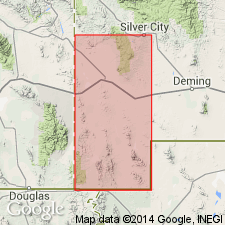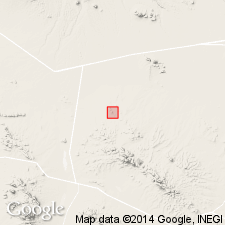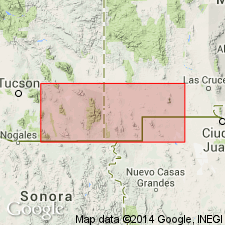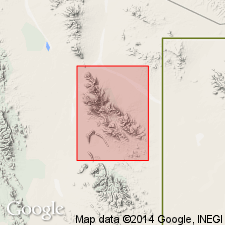
- Usage in publication:
-
- Keating Formation
- Modifications:
-
- Named
- Dominant lithology:
-
- Limestone
- AAPG geologic province:
-
- Pedregosa basin
- Basin-and-Range province
Summary:
Named as basal formation of Escabrosa Group for Keating Canyon in the Chiricahua Mountains, AZ in the Pedregosa basin. Type section on southeast side of Blue Mountain in sec 20, T26 [16] S, R30E, AZ. Is present in the Tombstone Hills, AZ, the Big Hatchet Mountains, Peloncillo Mountains, and Klondyke Hills, NM in the Basin-and-Range province. Is divided into members A and B. Member A (distinguished by almost complete absence of nodular chert) consists of basal encrinite with pore space filled with microcrystalline ooze and some sparry calcite; and upper fossiliferous "coral zone" of massive, dark-gray limestone with minor nodular chert and wide range of microlithologies containing as much as 75 percent oolites. Member B is thin bedded and highly cherty (20-40 percent brown, nodular chert); lower part is calcilutite, gray to dark-gray, lithographic limestone consisting of microcrystalline calcite matrix rich in fecal pellets with isolated brachiopods and corals; grades up into calcarenites and coquina limestones, dark-gray and composed of shell hash fragments 0.4 mm to 10 mm, and pore space filled with brown pellets as large as 0.3 mm, microcrystalline calcite, and minor clay. Ranges in thickness from 350 to 590 ft. Overlies Upper Devonian Portal Formation with paraconformity. Overlain by Hachita Formation. Is of Mississippian (Kinderhookian? and Osagean) age on basis of fossil corals, foraminifers, blastoids, and brachiopods.
Source: GNU records (USGS DDS-6; Denver GNULEX).

- Usage in publication:
-
- Keating Formation
- Modifications:
-
- Not used
Summary:
Of Armstrong (1962), not a useful mapping unit. The formation is rejected in the Big Hatchet Mountains area in the Pedregosa basin. Mississippian Escabrosa Limestone divided into lower, middle, and upper members used instead of Escabrosa Group.
Source: GNU records (USGS DDS-6; Denver GNULEX).

- Usage in publication:
-
- Keating Formation*
- Modifications:
-
- Overview
- Biostratigraphic dating
- AAPG geologic province:
-
- Basin-and-Range province
Summary:
Is lower formation (of two) of Escabrosa Group in the Klondike Hills, Grant and Luna Cos, NM in the southeastern part of Basin-and-Range province. Overlies Box Member of Percha Shale disconformably. Underlies Hachita Formation of Escabrosa with gradational contact. Is subdivided into informal members: Lower member A, 125 ft thick; upper member B, 575 ft thick. On basis of fossils, member A-member B contact approximates Kinderhook-Osage boundary. Member A may be assignable to megafossil zone C1 of Sando et al. (1969). Osage index fossil IMBREXIA FORBESI very common in upper 50 ft of member B. Age is Early Mississippian (Kinderhook-Osage).
Source: GNU records (USGS DDS-6; Denver GNULEX).

- Usage in publication:
-
- Keating Formation*
- Modifications:
-
- Overview
- AAPG geologic province:
-
- Pedregosa basin
Summary:
Basal formation of Escabrosa Group, mapped in Peloncillo Mountains, Hidalgo Co, NM in Pedregosa basin. Disconformably overlies Box Member of Percha Shale (Upper Devonian). Overlain by Hachita Formation (Lower and Upper Mississippian) of Escabrosa Group [Drewes and Thorman (1980) mapping in same area, described a member of Escabrosa Limestone that is possibly correlative with Keating Formation]. Is 111 m thick. Is of Early Mississippian age; [apparently on basis of previous work].
Source: GNU records (USGS DDS-6; Denver GNULEX).

- Usage in publication:
-
- Keating Formation*
- Modifications:
-
- Age modified
- AAPG geologic province:
-
- Pedregosa basin
- Basin-and-Range province
Summary:
Subdivided into Bugle and Witch Members in the Klondike Hills, Cedar Mountains, and Peloncillo Mountains, NM, and Chiricahua and Pedregosa Mountains, AZ in the Basin-and-Range province and Pedregosa basin. Is of late early to middle Tournaisian (Early Mississippian) age on basis of fossil brachiopods and foraminifers.
Source: GNU records (USGS DDS-6; Denver GNULEX).

- Usage in publication:
-
- Keating Formation*
- Modifications:
-
- Not used
- Overview
Summary:
Not recognized in central Peloncillo Mountains, NM in the Pedregosa basin where previously mapped by Armstrong and others (1978) as the lower formation of Escabrosa Group. Rather, the Escabrosa Limestone is described as containing a member possibly correlative with the Keating Formation. Is of Mississippian age.
Source: GNU records (USGS DDS-6; Denver GNULEX).

- Usage in publication:
-
- Keating Member*
- Modifications:
-
- Mapped 1:24k
- Revised
- Dominant lithology:
-
- Limestone
- AAPG geologic province:
-
- Pedregosa basin
Summary:
Keating Member of Escabrosa Limestone (local). Mapped in Big Hatchet Mountains, Hidalgo County, southwestern New Mexico. Very light-gray to medium-gray, medium- to thick-bedded, medium- to coarse-grained cherty limestone. Thickness about 890 feet (275 m). Includes: white unit, slightly crinoidal limestone with chert; black unit, coral-bearing limestone with some interbedded calcareous shale. Conformably underlies Hachita Member (revised locally) of Escabrosa; overlies Percha Shale (Upper Devonian). Fossiliferous (crinoids, corals, brachiopods). Age is Early Mississippian.
Source: Publication.
For more information, please contact Nancy Stamm, Geologic Names Committee Secretary.
Asterisk (*) indicates published by U.S. Geological Survey authors.
"No current usage" (†) implies that a name has been abandoned or has fallen into disuse. Former usage and, if known, replacement name given in parentheses ( ).
Slash (/) indicates name conflicts with nomenclatural guidelines (CSN, 1933; ACSN, 1961, 1970; NACSN, 1983, 2005, 2021). May be explained within brackets ([ ]).

